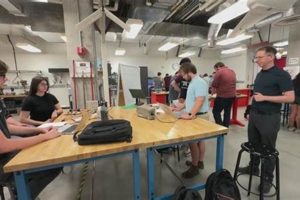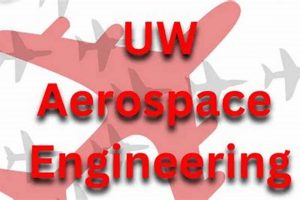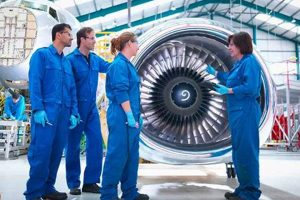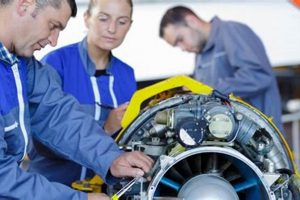The question of whether a professional trained in electrical engineering can transition into the aerospace field is a common one. Electrical engineering focuses on the design, development, and testing of electrical systems and components, while aerospace engineering concerns itself with the design, construction, and science of aircraft and spacecraft. The feasibility of such a career shift hinges on the individual’s preparedness to acquire additional knowledge and skills pertinent to the aerospace domain.
The benefits of this potential career change include expanding career opportunities, potentially leading to higher earning potential, and contributing to a technologically advanced and impactful sector. Historically, individuals with strong engineering fundamentals have successfully adapted to different engineering disciplines, leveraging transferable skills and pursuing targeted professional development. A deep understanding of mathematics, physics, and software, which are often core to both disciplines, provides a solid foundation for a successful transition.
The subsequent discussion will delve into the specific areas where an electrical engineer’s background is advantageous in aerospace engineering, outline the knowledge gaps that must be addressed, and explore the educational or professional development pathways that facilitate such a transition. Topics such as avionics systems, control systems, and the importance of understanding aerospace-specific design principles will be explored.
Guidance for Electrical Engineers Entering Aerospace
This section provides focused advice for electrical engineers seeking a career in aerospace engineering. It highlights essential strategies for a successful transition.
Tip 1: Emphasize Foundational Knowledge: Highlight proficiency in fundamental engineering principles such as circuit analysis, signal processing, and control systems. These are readily transferable to aerospace applications like avionics and guidance systems.
Tip 2: Acquire Aerospace-Specific Knowledge: Pursue coursework or professional development opportunities focusing on aerodynamics, propulsion, aircraft structures, and spacecraft design. This targeted learning fills critical knowledge gaps.
Tip 3: Develop Proficiency in Relevant Software: Become skilled in software tools commonly used in aerospace engineering, such as MATLAB, Simulink, and CAD software for mechanical design. Familiarity with these tools is crucial for design and simulation tasks.
Tip 4: Seek Cross-Disciplinary Projects: Participate in projects that involve both electrical and aerospace engineering aspects. This allows for the practical application of electrical engineering skills in an aerospace context and fosters collaboration.
Tip 5: Network with Aerospace Professionals: Attend industry conferences, join professional organizations like AIAA (American Institute of Aeronautics and Astronautics), and connect with aerospace engineers. Networking provides insights into industry trends and potential opportunities.
Tip 6: Tailor Resume and Cover Letter: Customize application materials to specifically address the requirements of aerospace engineering positions. Highlight relevant experience and demonstrate a clear understanding of the role and the aerospace industry.
Tip 7: Obtain Relevant Certifications: Consider pursuing certifications related to specific aerospace areas, such as FAA certifications for avionics technicians or certifications in systems engineering. These credentials enhance credibility.
The careful application of these tips will significantly improve the likelihood of a successful career transition, allowing individuals to leverage their electrical engineering background in the challenging and rewarding field of aerospace.
The next section will address potential career paths available to electrical engineers within the aerospace industry.
1. Transferable Skills
The potential for an electrical engineer to transition into aerospace engineering is significantly influenced by the presence of transferable skills. These skills, honed in the electrical engineering domain, provide a foundation upon which aerospace-specific knowledge can be built. The extent to which these skills align with the requirements of aerospace roles dictates the relative ease and success of the career shift.
- Circuit Design and Analysis
Electrical engineers possess expertise in circuit design, analysis, and testing. This knowledge is directly applicable to the design of avionics systems, power distribution networks within aircraft and spacecraft, and sensor interfaces. For example, designing a robust power supply for a satellite payload leverages skills honed in electrical circuit design.
- Signal Processing and Communication Systems
Signal processing techniques, essential in electrical engineering for analyzing and manipulating signals, are vital in aerospace for processing sensor data, managing communication links between aircraft or spacecraft and ground stations, and developing radar systems. Developing algorithms to filter noise from telemetry data transmitted from a spacecraft represents a practical application.
- Control Systems Engineering
Control systems expertise, focusing on designing and implementing systems to regulate and stabilize dynamic processes, is crucial in aerospace for designing flight control systems, attitude control systems for satellites, and guidance systems for missiles. Developing a feedback control loop to maintain the altitude of a drone is an example of applying these skills.
- Software Development and Programming
Proficiency in software development and programming, often utilized for modeling, simulation, and control, is beneficial in aerospace for developing embedded systems for aircraft, creating simulation software for aerodynamic analysis, and designing user interfaces for flight control systems. Writing code to automate the analysis of flight test data demonstrates a useful transferable skill.
- Mathematical Modeling and Analysis
A strong foundation in mathematical modeling and analysis enables the creation of accurate simulations of aerospace systems. This skill applies to various aspects of design and analysis, such as structural dynamics, heat transfer, and fluid dynamics. Developing a mathematical model of the atmosphere for simulating the trajectory of a rocket utilizes these essential skills.
The presence and effective utilization of these transferable skills significantly enhance the viability of a career change from electrical to aerospace engineering. By leveraging existing strengths and supplementing them with aerospace-specific knowledge, electrical engineers can successfully navigate this transition and contribute to the advancements in the aerospace sector. The emphasis remains on identifying, highlighting, and applying these skills within the new context of aerospace challenges.
2. Additional education
The prospect of an electrical engineer successfully transitioning into aerospace engineering is significantly predicated on the acquisition of additional, specialized education. While a background in electrical engineering provides a robust foundation in mathematics, physics, and fundamental engineering principles, it typically lacks the domain-specific knowledge crucial for aerospace applications. Aerodynamics, propulsion, aerospace structures, and orbital mechanics are areas where further education is often indispensable. This additional learning directly affects the engineer’s ability to design, analyze, and contribute effectively to aerospace projects. For example, an electrical engineer working on satellite communication systems might require additional education in orbital mechanics and space environment effects to fully understand the operational constraints and design optimal solutions.
The form of this additional education can vary, ranging from formal graduate degrees in aerospace engineering to specialized courses or certificate programs focused on specific areas of interest, such as computational fluid dynamics or finite element analysis for aerospace structures. Furthermore, on-the-job training and mentorship programs within aerospace companies can provide invaluable practical experience and facilitate the application of newly acquired knowledge. A common scenario involves an electrical engineer pursuing a master’s degree in aerospace engineering with a focus on control systems, allowing them to leverage their existing control theory expertise while learning the specific challenges of flight control and guidance systems for aircraft or spacecraft.
In conclusion, the correlation between additional education and the feasibility of a career shift from electrical to aerospace engineering is strong and direct. While foundational knowledge is advantageous, it is insufficient without targeted education in aerospace-specific domains. Overcoming this knowledge gap is essential for building credibility, demonstrating competence, and effectively contributing to the complex and demanding field of aerospace engineering. The commitment to lifelong learning and the willingness to invest in additional education are therefore critical attributes for electrical engineers seeking to pursue this transition.
3. Industry Demand
The aerospace industry’s demand for skilled engineers significantly influences the career transition potential for electrical engineers. The industry’s needs often align with skill sets possessed by electrical engineers, creating opportunities for those willing to adapt and acquire additional aerospace-specific expertise.
- Avionics Systems
The aerospace sector exhibits a consistent demand for engineers specializing in avionics systems, encompassing communication, navigation, and control systems within aircraft and spacecraft. Electrical engineers’ expertise in circuit design, signal processing, and embedded systems directly translates to these avionics applications. For instance, the design and integration of advanced radar systems or flight management systems represent areas where electrical engineers can contribute substantially.
- Power Systems
Aircraft and spacecraft require robust and efficient power systems for various functions, including propulsion, communication, and life support. Electrical engineers with experience in power electronics, power distribution, and energy management are highly sought after to design and maintain these systems. The development of electric propulsion systems for satellites and the optimization of power consumption in unmanned aerial vehicles (UAVs) exemplify the role of electrical engineers in this domain.
- Control Systems
Precise control systems are essential for the safe and efficient operation of aircraft, spacecraft, and missiles. Electrical engineers with a background in control theory, feedback control systems, and automation are well-positioned to contribute to the design and implementation of these systems. The development of autopilot systems for commercial aircraft and the design of guidance and control systems for rockets are specific examples.
- Embedded Systems
Aerospace vehicles rely heavily on embedded systems for various functions, including data acquisition, sensor processing, and real-time control. Electrical engineers with expertise in embedded systems programming, microcontrollers, and hardware-software integration are crucial for developing and maintaining these systems. The development of onboard diagnostic systems for aircraft engines and the design of control units for satellite subsystems demonstrate the relevance of embedded systems expertise.
In summary, the aerospace industry’s ongoing need for skilled engineers in areas such as avionics, power systems, control systems, and embedded systems provides viable pathways for electrical engineers seeking a career change. By leveraging their existing skills and acquiring targeted aerospace-specific knowledge, electrical engineers can effectively meet the demands of the industry and contribute to advancements in aerospace technology.
4. Specific aerospace roles
The feasibility of an electrical engineer transitioning to aerospace engineering is intrinsically linked to the specific roles within the aerospace sector. The relevance of an electrical engineer’s skill set varies significantly depending on the particular job function. Some roles require a deep understanding of aerodynamics or structural mechanics, areas typically outside the scope of electrical engineering education. Other roles, however, heavily utilize electrical engineering principles, making the transition more attainable. For example, an electrical engineer specializing in power systems might find a natural fit in designing power distribution networks for satellites. Conversely, a role focused on aerodynamic design of aircraft wings would necessitate substantial additional training.
Aerospace roles where an electrical engineering background proves particularly advantageous include avionics engineering, specializing in the design and integration of electronic systems within aircraft. Other relevant areas include power systems engineering, focusing on the generation, storage, and distribution of electrical power in aerospace vehicles; control systems engineering, dealing with the design of automated control systems for flight and navigation; and communications engineering, involving the development of communication systems for spacecraft and aircraft. In each of these areas, the core electrical engineering knowledge is directly applicable, requiring further specialized training on aerospace-specific considerations such as radiation hardening for space-based electronics or altitude compensation for aircraft systems.
In summary, the ease with which an electrical engineer can enter the aerospace field depends heavily on aligning their existing skills and experience with specific roles within the industry. Some positions necessitate extensive retraining, while others offer a more seamless transition path. Identifying target roles that leverage existing strengths while acknowledging the need for continued learning is crucial for a successful career shift. The availability of relevant training resources and mentorship programs further facilitates this transition, enabling electrical engineers to contribute effectively to the aerospace sector.
5. Avionics Expertise
Avionics expertise represents a pivotal factor in evaluating whether an electrical engineer can transition to aerospace engineering. This specialization, encompassing the electronic systems used on aircraft, satellites, and spacecraft, directly aligns with the core skills of electrical engineering. The extent of an electrical engineer’s avionics knowledge significantly impacts the feasibility and success of such a career shift.
- Design and Integration of Electronic Systems
Avionics expertise involves designing and integrating various electronic systems, including communication, navigation, flight control, and radar systems. Electrical engineers with experience in circuit design, signal processing, and embedded systems are well-equipped to contribute to these areas. For example, designing a flight management system requires a deep understanding of both hardware and software, skills commonly possessed by electrical engineers.
- Testing and Certification
Avionics systems must undergo rigorous testing and certification to ensure safety and reliability. Electrical engineers with experience in testing and validation can play a crucial role in this process, ensuring that avionics systems meet stringent regulatory requirements. Performing electromagnetic compatibility (EMC) testing on avionics equipment is an example of this crucial work.
- Maintenance and Troubleshooting
Avionics systems require ongoing maintenance and troubleshooting to ensure continued safe operation. Electrical engineers with expertise in fault diagnosis and repair can contribute to maintaining these systems, identifying and resolving issues that may arise. Diagnosing and repairing a malfunctioning autopilot system exemplifies this function.
- Emerging Technologies
The field of avionics is constantly evolving, with new technologies such as artificial intelligence, machine learning, and advanced sensors being integrated into aircraft and spacecraft. Electrical engineers with expertise in these emerging technologies can contribute to developing innovative avionics solutions. Developing AI-powered flight control algorithms represents a cutting-edge application of electrical engineering in avionics.
The depth and breadth of an electrical engineer’s avionics expertise directly influences the ease with which they can transition to aerospace engineering. Strong avionics skills provide a valuable foundation for contributing to the design, testing, maintenance, and advancement of aerospace electronic systems. While additional aerospace-specific knowledge may be required, a solid background in avionics significantly enhances the potential for a successful career shift.
6. Control systems knowledge
Control systems knowledge forms a crucial bridge enabling an electrical engineer to become an aerospace engineer. The design, analysis, and implementation of control systems are fundamental in both disciplines, though the specific applications and environmental considerations differ. An electrical engineer proficient in control theory, feedback control loops, and system modeling possesses a significant advantage when transitioning to the aerospace field. Aircraft stability augmentation, spacecraft attitude control, and missile guidance systems all rely heavily on control engineering principles. The effectiveness of these systems directly impacts performance and safety, making control systems expertise indispensable. For example, the design of a robust autopilot system for an aircraft necessitates a deep understanding of control algorithms and their implementation using electronic hardware an area where an electrical engineer with control systems knowledge can readily contribute.
The practical application of control systems knowledge in aerospace engineering extends to diverse areas such as robotics for space exploration and the development of autonomous flight systems. Electrical engineers contribute to the design of actuators, sensors, and embedded controllers that form the basis of these systems. Furthermore, the modeling and simulation of complex aerospace systems often require advanced control techniques to ensure stability and performance under varying conditions. Consider the design of a satellite’s reaction control system; this involves precise modeling of the spacecraft’s dynamics and the development of control algorithms to maintain its orientation in orbit, a task well-suited for an electrical engineer familiar with control systems. Similarly, designing the control system for a drone requires balancing stability, maneuverability, and energy efficiency, demanding expertise in control systems and embedded systems integration.
In conclusion, control systems knowledge provides a strong foundation for electrical engineers aspiring to enter the aerospace field. While aerospace-specific knowledge in areas such as aerodynamics and orbital mechanics remains essential, the core principles of control engineering translate directly to numerous critical applications. By leveraging their existing skills and acquiring further training in aerospace-specific areas, electrical engineers with a solid understanding of control systems can effectively contribute to the design, development, and analysis of complex aerospace systems. The challenge lies in adapting existing knowledge to the specific constraints and requirements of aerospace applications, a task achievable through targeted education and practical experience.
7. Certification Needs
Certification needs constitute a significant consideration for electrical engineers seeking a transition into aerospace engineering. The acquisition of relevant certifications can validate competence, enhance credibility, and fulfill regulatory requirements within the aerospace sector, thereby influencing the feasibility of such a career change.
- FAA Certifications (e.g., A&P, Avionics Technician)
The Federal Aviation Administration (FAA) offers certifications such as Airframe and Powerplant (A&P) mechanic and Avionics Technician. These certifications demonstrate competency in maintaining and repairing aircraft systems, including electrical and electronic components. An electrical engineer pursuing a role in aircraft maintenance or avionics servicing may find these certifications essential for meeting regulatory requirements and demonstrating practical skills. Without these certifications, opportunities in certain areas of aircraft maintenance may be limited, despite an electrical engineering background.
- Professional Engineering (PE) License
A Professional Engineering (PE) license, while not always mandatory, can significantly enhance career prospects in aerospace engineering. It signifies a commitment to ethical practice and a demonstrated level of competence. In some states and for certain engineering roles, a PE license may be required for signing off on engineering designs or supervising engineering work. An electrical engineer transitioning to aerospace might pursue a PE license in a relevant engineering discipline to increase their credibility and eligibility for leadership positions.
- Systems Engineering Certifications (e.g., INCOSE)
Systems engineering certifications, such as those offered by the International Council on Systems Engineering (INCOSE), demonstrate proficiency in managing complex projects and integrating various engineering disciplines. Given the inherently multidisciplinary nature of aerospace projects, possessing a systems engineering certification can be advantageous for electrical engineers seeking roles in project management or systems integration. This certification validates the ability to effectively coordinate electrical engineering contributions within the larger aerospace project lifecycle.
- Specialized Aerospace Certifications (e.g., Composites, NDT)
Certain specialized certifications within the aerospace industry focus on specific materials, processes, or testing methodologies. Examples include certifications in composite materials manufacturing or Non-Destructive Testing (NDT) techniques. While these certifications may not directly relate to electrical engineering, acquiring relevant specialized certifications demonstrates a commitment to continuous learning and a willingness to adapt to the specific requirements of the aerospace industry. An electrical engineer working on the integration of sensors into composite aircraft structures might benefit from understanding composite materials and their inspection techniques.
The specific certification needs for an electrical engineer transitioning to aerospace engineering vary depending on the target role and the employer’s requirements. While foundational knowledge in electrical engineering is valuable, relevant certifications can serve as a crucial bridge, demonstrating competence and adherence to industry standards, thereby increasing the likelihood of a successful career transition. The emphasis on safety and reliability within the aerospace sector underscores the importance of validated expertise through recognized certification programs.
Frequently Asked Questions
This section addresses common inquiries regarding the possibility of a career transition from electrical engineering to aerospace engineering. The information provided is intended to offer clarity and guidance to those considering such a move.
Question 1: Is a complete retraining in aerospace engineering necessary for an electrical engineer to enter the field?
A complete retraining is generally not necessary, but targeted education is essential. Electrical engineering provides a solid foundation in mathematics, physics, and circuit design. However, specific aerospace knowledge in areas such as aerodynamics, propulsion, and orbital mechanics must be acquired through additional coursework or professional development.
Question 2: What specific skills from electrical engineering are most valuable in aerospace engineering?
Skills in circuit design, signal processing, control systems, and embedded systems are highly valuable. These skills are directly applicable to areas such as avionics, power systems, and control systems design within aerospace vehicles.
Question 3: What are the primary knowledge gaps an electrical engineer must address to work in aerospace engineering?
The primary knowledge gaps typically involve aerodynamics, aerospace structures, propulsion systems, orbital mechanics (for space-related roles), and aerospace materials. Understanding the unique environmental factors affecting aerospace vehicles, such as radiation in space or extreme temperatures, is also crucial.
Question 4: Are there specific aerospace roles that are more accessible to electrical engineers?
Yes. Roles in avionics engineering, power systems engineering, control systems engineering, and embedded systems development are often more accessible due to the direct applicability of electrical engineering principles. These roles leverage existing skills while requiring adaptation to aerospace-specific contexts.
Question 5: How important are certifications for electrical engineers seeking aerospace engineering positions?
Certifications can be beneficial, particularly in areas like avionics maintenance (FAA certifications) or systems engineering (INCOSE certifications). While not always mandatory, certifications demonstrate competence and enhance credibility, particularly in safety-critical areas.
Question 6: Is prior aerospace experience a prerequisite for electrical engineers transitioning to aerospace roles?
Prior aerospace experience is not always a strict prerequisite, but it can significantly improve competitiveness. Lacking direct aerospace experience, electrical engineers should emphasize relevant projects, coursework, or professional development activities that demonstrate their commitment to and aptitude for the aerospace field.
Key takeaways indicate that the transition is viable with focused effort. Demonstrating transferable skills, acquiring specialized knowledge, and potentially pursuing relevant certifications are all crucial steps.
The subsequent discussion will explore strategies for networking and building connections within the aerospace industry to further facilitate this career transition.
Conclusion
The preceding exploration of “can an electrical engineer become an aerospace engineer” demonstrates that such a career transition is indeed feasible, though not without deliberate effort. Success hinges on leveraging transferable skills, strategically addressing knowledge gaps through further education or training, and aligning oneself with specific aerospace roles where electrical engineering expertise is directly applicable. While complete retraining is generally unnecessary, the acquisition of aerospace-specific knowledge in areas such as aerodynamics and propulsion is crucial.
Ultimately, the decision to pursue this path necessitates a careful evaluation of one’s existing skills, a realistic assessment of the required effort, and a proactive approach to acquiring the necessary knowledge and credentials. The potential rewards of contributing to the technologically advanced and impactful field of aerospace engineering justify the commitment for those with the requisite aptitude and determination. The future of aerospace innovation relies on a diverse workforce, and engineers from various disciplines, including electrical engineering, have a vital role to play.




![Best Aerospace Engineering Colleges in Kentucky [Ranked] Innovating the Future of Flight with Reliable Aviation Solutions Best Aerospace Engineering Colleges in Kentucky [Ranked] | Innovating the Future of Flight with Reliable Aviation Solutions](https://mixaerospace.com/wp-content/uploads/2025/12/th-760-300x200.jpg)


